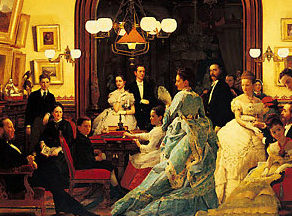
The Vanderbilts
The Family that Built a Transportation Empire
From biltmore.com
The Vanderbilt Family
The Vanderbilts were one of the oldest and best-known families in America. Jan Aertsen van der Bilt emigrated from Holland around 1650. Although his descendants prospered as farmers on Staten Island, New York, they lived modestly; it was only during the lifetime of Cornelius Vanderbilt (1794-1877), known as the “Commodore,” that the family name became synonymous with extraordinary wealth.
Patriarch to a sizable family—including his wife of 53 years, Sophia, 13 children, 37 grand-children, and 27 great-grandchildren—Cornelius established what became the Vanderbilt custom of luxurious residences. He also began the tradition of philanthropy, contributing $1 million in 1873 to Central University, a Methodist school in Nashville; it was later renamed Vanderbilt University.
Upon his death, the Commodore left most of his $100 million estate—a sum that made him the wealthiest industrialist of his time—to his eldest son, William Henry (1821-85). William Henry took over the family empire and eventually doubled its assets. He, too, was generous toward worthy causes, funding the Metropolitan Opera in 1883 and endowing the College of Physicians and Surgeons, now the Medical School of Columbia University. The shrewd financier proved to be an equally astute collector, assembling more than 200 paintings. These were displayed in the 59-room mansion he built in 1881 at 640 Fifth Avenue—the largest and most splendid house in Manhattan.
William K. Vanderbilt Jr. (1878-1944) was the great-grandson of Commodore Cornelius Vanderbilt. Known to his friends as Willie K, he was the second child and first son of William K. Vanderbilt (1849-1920) and Alva Erskine Smith (1849-1933). He was a railroad executive, an accomplished yachtsman, and a pioneer auto racing driver. At the age of only 26, William K. Vanderbilt Jr. proposed the first international road race to be held in the United States by donating the Vanderbilt Cup.

hi, how do you date the chassis of a car with the fedco plate? my fedco plate read
YYY EEE ZERO THRE ONE WWW, so the…